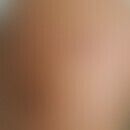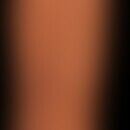Synonym(s)
HistoryThis section has been translated automatically.
DefinitionThis section has been translated automatically.
Hereditary, familial or sporadic, very rare syndrome characterized by multiple neoplasms originating from the connective tissue of the hair shaft and diseases of various extracutaneous organs, especially the lungs and kidneys. lungs and kidneys.
You might also be interested in
EtiopathogenesisThis section has been translated automatically.
The syndrome is secondary to a germline mutation in the folliculin(FLCN) gene, which is located on chromosome 17p11.2 and codes for the folliculin protein (Baba M et al. 2006). A number of mutations have been identified, including deletions, substitutions and duplications, which are thought to lead to a truncation of the protein and thus to a loss of function.
Folliculin is expressed in a number of normal tissues such as skin, lung and kidney, although the exact function of the protein remains unknown. Recent evidence suggests that folliculin acts as a tumor suppressor via an interaction with the mTOR energy processing pathway and its absence contributes to the development of BHDS-associated renal tumors. There may be subtypes of BHDS, as pulmonary cysts are the predominant feature in some families and skin and renal manifestations are less common. In addition, mutations may be specific to certain ethnicities, as different mutation distributions and unique alterations have been found in Japanese and Caucasian patients
Involvement of the VHL and tyrosinase kinase domains of the Met proto-oncogene family as well as the PTCH, PTEN and CTNNB1 genes have also been described.
ManifestationThis section has been translated automatically.
LocalizationThis section has been translated automatically.
ClinicThis section has been translated automatically.
- Integument: Multiple, skin-colored, flesh-colored or waxy shiny, relatively coarse, 2-5 mm in size, hemispherical asymptomatic papules, often oral. These are usually combinations of histologically different structures, e.g.
- Fibrofolliculoma
- trichodiscoma (tumors of the hair disc)
- Fibroma molle or perifollicular fibroma (see also hair follicle tumor)
- Lipoma
- Angiolipoma
- Basal cell carcinoma
- Connective tissue nevus
- Cutaneous, focal multiple mucinosis
- Extracutaneous manifestations:
- Colon: multiple colonic adenomas with a high risk of degeneration to colorectal carcinoma.
- Genitourinary tract: prostate carcinoma, renal cysts, renal angiolipomas, hyperuricemia.
- Lung: emphysema, bronchiectasis, lung cysts, hamartomas of the lung.
- Eyes: retinopathies, chorioretinopathies, glaucoma.
- Endocrine system: thyroid carcinoma, hypothyroidism, parathyroid adenoma, diabetes mellitus.
- Other: osteomas, hypertension, hepatic hemangiomas, uterine fibroids, facial nerve palsy, deafness, aplasia of anterior communicating artery.
Differential diagnosisThis section has been translated automatically.
TherapyThis section has been translated automatically.
Progression/forecastThis section has been translated automatically.
Regular colonoscopic screening examinations are urgently recommended (see also www.familienhilfe-polyposis.de).
Note(s)This section has been translated automatically.
LiteratureThis section has been translated automatically.
- Baba M et al. (2006) Folliculin encoded by the BHD gene interacts with a binding protein, FNIP1, and AMPK, and is involved in AMPK and mTOR signaling. Proc Natl Acad Sci U S A 103:15552-15527.
- Birt AR, Hogg GR, Dube WJ (1977) Hereditary multiple fibrofilliculomas with trichodiscomas and acrochordons. Arch Dermatol 113: 1674-1677
- Bournier R et al (1925) Fibromes sous-cutanes peripilaires multiples du cou. Bull Soc Fr Dermatol Syph 32: 242-243
- Bruce H et al (2009) Cutaneous manifestations of internal malignancy. Cancer J Clin 59: 73-98
- Frantzen B et al (2001) Hornstein-Knickenberg and Birt-Hogg-Dube syndrome. Report of a case with spontaneous pneumothorax and aplasia of the left internal carotid artery. Dermatology 52: 1016-1020
- Gambichler T et al. (2000) Treatment of Birt-Hogg-Dube syndrome with erbium:YAG laser. J Am Acad Dermatol 43: 856-858
- Hornstein OP, Knickenberg M (1975) Perifollicular fibromatosis cutis with polyps of the colon- a cutaneo-intestinal syndrome sui generis. Arch Derm Res 253: 161-175
- Lindor NM et al. (2001) Birt-Hogg-Dube syndrome: an autosomal dominant disorder with predisposition to cancers of the kidney, fibrofolliculomas, and focal cutaneous mucinosis. Int J Dermatol 40: 653-656
- Nickerson ML et al. (2002) Mutations in a novel gene lead to kidney tumors, lung wall defects, and benign tumors of the hair follicle in patients with the Birt-Hogg-Dube syndrome. Cancer Cell 2: 157-164
- Okimoto K et al. (2004) A germ-line insertion in the Birt-Hogg-Dube (BHD) gene gives rise to the Nihon rat model of inherited renal cancer. Proc Natl Acad Sci U S A 101: 2023-2027
PDQ Cancer Genetics Editorial Board (2023) Birt-Hogg-Dubé Syndrome (PDQ®): Health Professional Version. 2023 Oct 30. In: PDQ Cancer Information Summaries [Internet]. Bethesda (MD): National Cancer Institute (US) 2002-. PMID: 33724752.
- Schulz T, Hartschuh W (2000) Characteristics of the Birt-Hogg-Dube/Hornstein-Knickenberg syndrome. Am J Dermatopathol 22: 293-294
- Schulz T, Hartschuh W (1999) Birt-Hogg-Dube syndrome and Hornstein-Knickenberg syndrome are the same. Different sectioning technique as the cause of different histology. J Cutan Pathol 26: 55-61
- Vincent A et al. (2003) Birt-Hogg-Dube syndrome: a review of the literature and the differential diagnosis of firm facial papules. J Am Acad Dermatol 49: 698-705
- Vincent A et al. (2003) Birt-Hogg-Dube syndrome: two patients with neural tissue tumors. J Am Acad Dermatol 49: 717-719
- Warren MB et al. (2004) Expression of Birt-Hogg-Dube gene mRNA in normal and neoplastic human tissues. Mod Pathol 17: 998-1011
Incoming links (16)
Cutaneous focal mucinosis ; Eye diseases, skin changes; Familial cancer syndrome; Fibrofolliculoma; Fibrofolliculomas, multiple; Fibroma perifollicular; Fibromatosis cutis, perifollicular, with colonic polyps; FLCN Gene; Folliculin; Multiple cutaneous focal mucinosis ; ... Show allOutgoing links (19)
Acanthosis nigricans (overview); Angiolipoma; Basal cell carcinoma (overview); Connective tissue nevus; Cowden syndrome; Fibrofolliculoma; Fibroma perifollicular; FLCN Gene; Folliculin; Goltz syndrome; ... Show allDisclaimer
Please ask your physician for a reliable diagnosis. This website is only meant as a reference.






